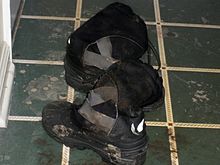Snow boot
Appearance
This article needs additional citations for verification. (February 2011) |

A snow boot is a type of boot, generally waterproof, or water-resistant. The boot, in almost all cases, has a high side, keeping snow from entering the boot, and a rubber sole, to keep water out. Because of their water-resistant material, snowboots are often used in wet, slushy, or muddy situations. This means not a half inch dusting of snow, of water, but quite deep, heavy wet snow, slush, or mud.[1]
Uses
Snowboots are used by people to easily walk in snowy or wet situations, and by children playing in snowy, relatively wet, or muddy lawns, fields, etc. They are also usable for walking in streams in winter, as they are well-insulated, while still waterproof.
Difference between snowboots and other boots
Snowboots have many differences between them
- Snow boots are waterproof or water resistant, but winter boots are not.
- The two boot types have different uses. The snowboot is used on very wet or snowy conditions, while winter boots are better used on well-maintained roads or paths, or even while shopping.
- Snowboots are made of easy-to-clean materials, but winter boots are not. However, this cleanability and waterproofing comes at the cost that snowboots are heavier, less breathable, and more expensive.
- Snowboots always extend partway up the leg, unlike hiking boots.
- Snowboots are always moderately to heavily insulated, with the insulation under the waterproof/water-resistant layer.
See also
